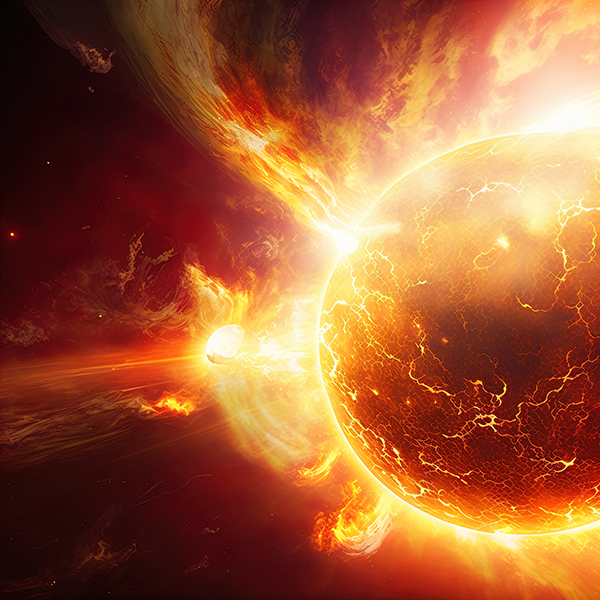Supermassive black hole discovered hiding in a galaxy 47 million light years from Earth
03/03/2023 / By Zoey Sky

According to a study published in the journal Nature, experts have discovered a supermassive black hole that has been hiding inside a cloud of cosmic dust.
The researchers used the European Southern Observatory’s Very Large Telescope Interferometer (ESO’s VLTI) in Chile to take detailed images of the dust cloud. They also studied data from the Atacama Large Millimeter/Submillimeter Array, co-owned by ESO and the National Radio Astronomy Observatory’s Very Long Baseline Array (VLBA), to construct their picture.
The research team turned the VLTI to the galaxy Messier 77 and they found a thick ring of cosmic dust that was hiding a supermassive black hole.
Messier 77 (M77) is about 47 million light-years away. It is one of the largest galaxies in the Messier catalog. Messier 77 was initially identified as a nebula by the French astronomer Pierre Mechain in 1780. The galaxy is located in the constellation Cetus.
For decades, the location of the black hole within the cloud of dust remained a mystery. To learn more about the black hole, scientists used detailed images from VLTI to measure the temperature at different points within the cloud to create a map.
Called an active galactic nuclei (AGN), the cloud surrounding the black hole fed it and gave off intense light that can outshine the stars in the galaxy.
AGNs are some of the brightest and most mysterious objects in the universe and they can be found at the heart of galaxies. According to experts, the findings could help them confirm the history of the supermassive black hole at the center of the Milky Way, Sagittarius A* (Sgr A*). (Related: Mysterious radio circles in outer space could be newfound remnants of black hole mergers, study suggests.)
Finding the black hole is a difficult task
Before the gas and dust in an AGN are eaten up by the black hole, the material spirals toward it.
This process then releases huge amounts of energy in the process and often outshines all the stars in the galaxy, a phenomenon that can be viewed by telescopes on Earth.
But locating the black hole, which emits no light of its own, can be as difficult as solving a complicated puzzle. To do this, scientists used detailed images and analysis of changes in dust temperature.
The research team used the data at hand to build a picture of the dust and pinpoint where the black hole could be located. The astronomers think the dust with the black hole at its core supports a decades-old model called the Unified Model of AGNs.
Violeta Gamez Rosas, the study’s lead researcher, explained that the real nature of the dust clouds and their role in both feeding the black hole and determining how it looks when viewed from Earth have been central questions in AGN studies for the last three decades.
AGNs were first spotted in the 1950s. Since then, astronomers have tried to learn more about them.
With the help of the VLTI, the research team conducting the study is one step closer to understanding how AGNs work and what they look like up close.
Astronomers have confirmed that there are different types of AGN and that some appear brighter than others. The model states that despite these differences, all AGNs have the same basic structure: a supermassive black hole encircled by a thick dust ring.
These observations validate the 30-year-old Unified Model of AGNs, which states that any difference in appearance between AGNs is due to the angle at which the black hole and its thick ring are viewed from Earth.
The type of AGN seen depends on how much of the space dust ring blocks the black hole from view. In some cases, the dust ring can also completely hide a black hole.
Experts stumbled upon some evidence to support the Unified Model before, including discovering warm dust at the center of Messier 77.
But it was uncertain whether this dust could completely hide a black hole. This also explains why this AGN doesn’t shine as brightly in visible light than other AGNs.
Gamez Rosas explained that the study findings could be used to learn more about the inner workings of AGNs. Additionally, the data could help researchers figure out the history of the Milky Way, which also has a supermassive black hole at its center that may have been active in the past.
The scientists are now planning to use ESO’s VLTI to gather more supporting evidence of the Unified Model of AGNs by considering a larger sample of galaxies.
Bruno Lopez, the MATISSE principal investigator at the Observatoire de la Côte d’Azur in Nice, France, explained that Messier 77 is an important prototype AGN. The galaxy can also help motivate other researchers to expand their observing program and optimize MATISSE to tackle a bigger sample of AGNs.
Visit Space.news to read more articles about fascinating space discoveries.
Watch the video below to watch a video showcasing the Milky Way from the Mauna Kea Observatories.
This video is from Cynthia’s Pursuit of Truth channel on Brighteon.com.
More related stories:
Straight out of sci-fi? Researchers say that aliens use black holes to travel.
Sources include:
Submit a correction >>
Tagged Under:
active galactic nuclei, astronomy, black hole, breakthrough, cosmic, discoveries, galaxy, Messier 77, Milky Way, observatory, Space, supermassive black hole
This article may contain statements that reflect the opinion of the author
RECENT NEWS & ARTICLES
COPYRIGHT © 2018 BREAKTHROUGH.NEWS
All content posted on this site is protected under Free Speech. Breakthrough.news is not responsible for content written by contributing authors. The information on this site is provided for educational and entertainment purposes only. It is not intended as a substitute for professional advice of any kind. Breakthrough.news assumes no responsibility for the use or misuse of this material. All trademarks, registered trademarks and service marks mentioned on this site are the property of their respective owners.




















